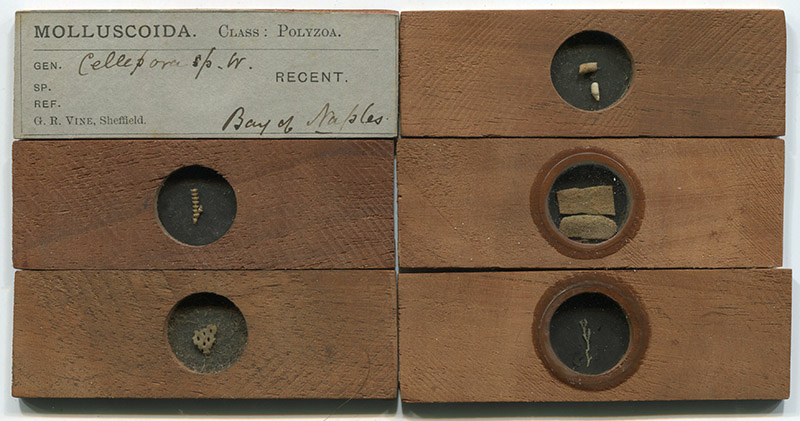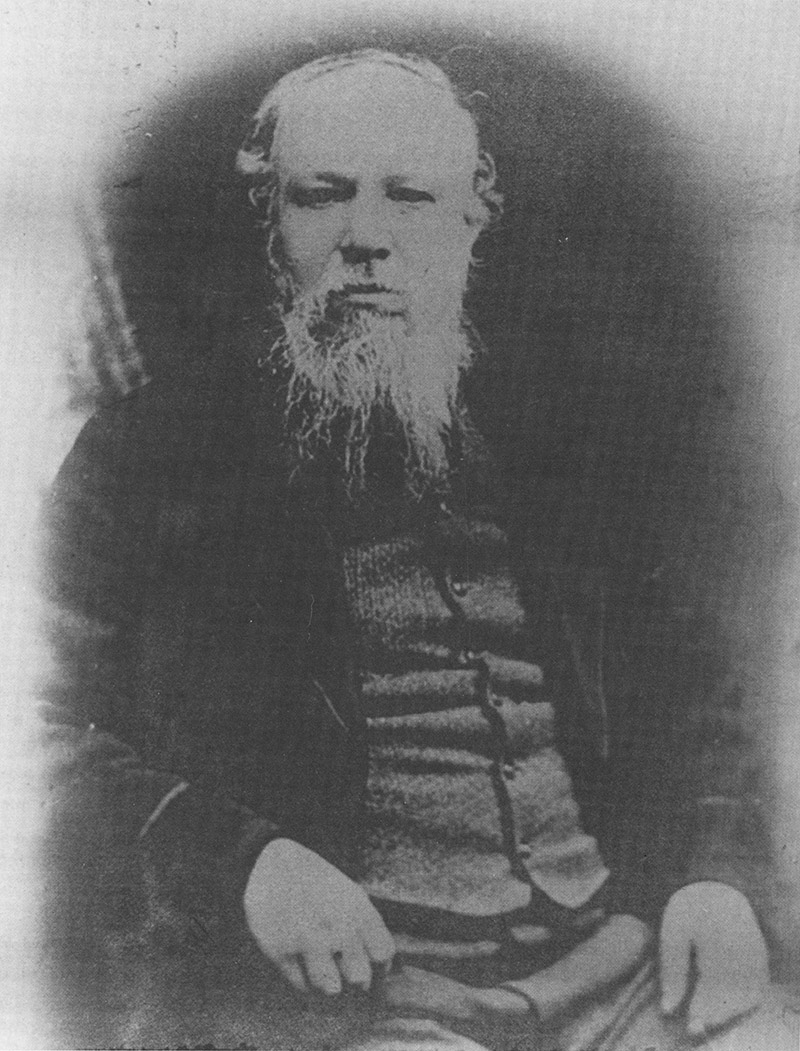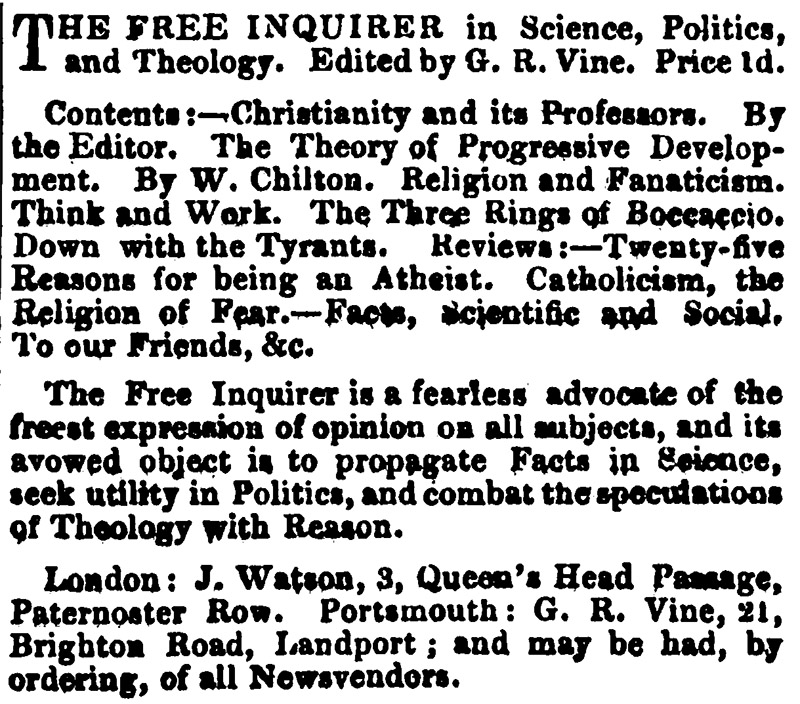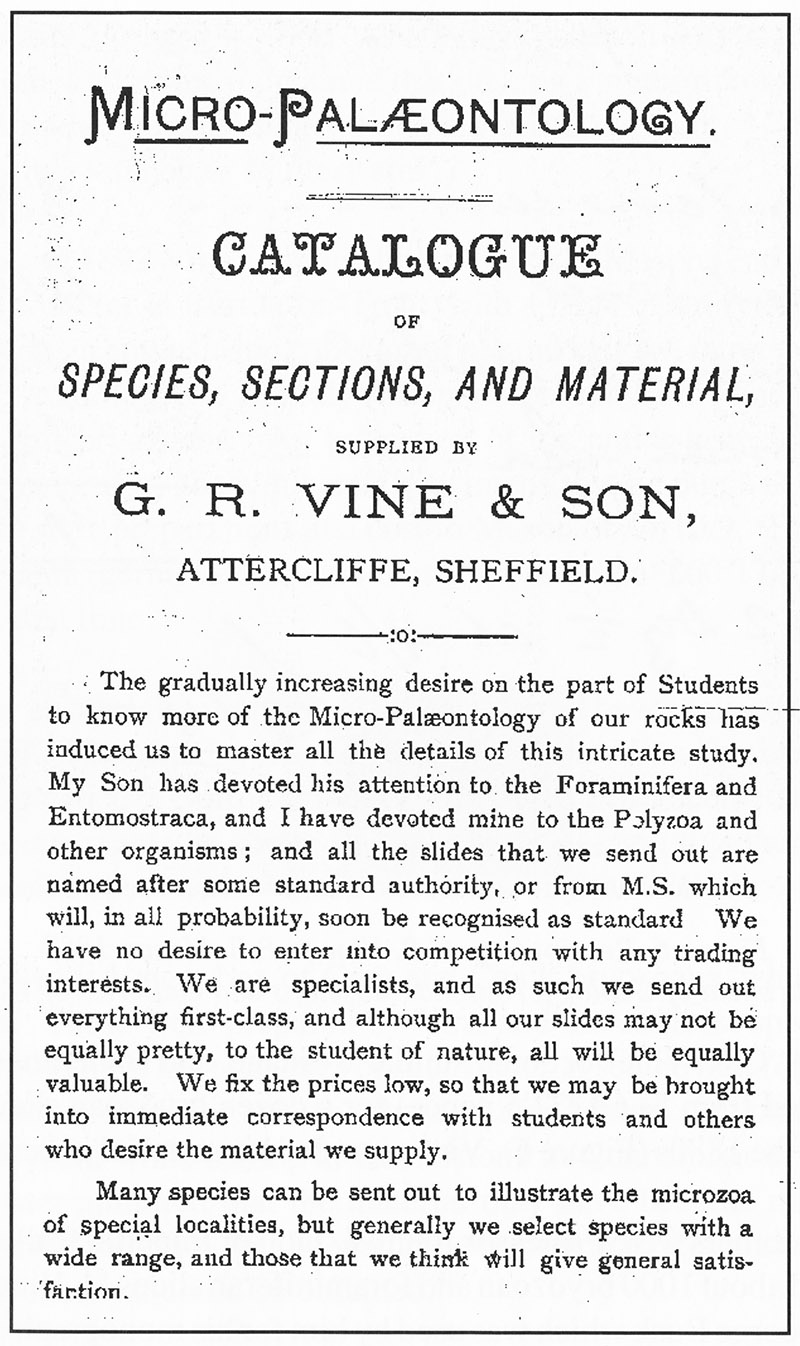George Robert Vine, 1825 - 1893
by Brian Stevenson
last updated March, 2017
G.R. Vine grew up poor, had a limited formal education, and lived a relatively modest life as a maker of stays and corsets. Nonetheless, he taught himself Greek and Latin, and wrote poetry. He developed an interest in geology, which was piqued when he learned that almost nothing was known about the fossil bryozoans he found. Vine took up that gauntlet in the mid-1870s, published his first serious scientific paper in 1876, and then published over 70 more before his death. Beginning in 1879, Vine served as Secretary for the Committee on Fossil Polyzoa of the British Association for the Advancement of Science, and received several small grants over the next decade. He received a Lyell Fund Award from the Geological Society of London in 1881.
Vine put his scientific hobby to commercial use. From about 1879 onward, he prepared and sold mounted fossils and other items from his home (Figure 1). In this, he was assisted by his son, George Robert Vine Jr. A printed catalogue offered 154 different samples of bryozoa, foraminifera, and ostracods, plus material such as dredgings from the voyages of the H.M.S. Challenger.

Figure 1.
Examples of mounted microscopical preparations by George R. Vine. All of these examples bear labels identifying the specimens as recent “Polyzoa” (i.e. Bryozoa). The slides are hardwood, possibly cedar, cut to standard 1 x 3 inch size and 1/8 inch thickness. The center holes are drilled straight through, then backed with black cardstock, which is covered with an identifying label. Some are covered with glass, but most were produced without cover slips, which would allow closer examination with a microscope lens. Since the specimens can best be studied by top-lighting, this arrangement makes more sense than if he had used glass slides. Vine wrote, “although all of our slides may not be equally pretty, to the student of nature, all will be equally valuable”.
George Vine was born on October 25, 1825, in Hassops, Portsea, Hampshire, which is near the city of Portsmouth. He was the second of Charles and Ann Vine’s four children. George’s father worked as a sailor for some time, and was described as being a “labourer” on the 1841 census. George’s son later wrote of his father, “His parents were poor, but brought up their children in strict conformity with their religious beliefs, and with such a sense of honour and honesty that their son George never wavered from the paths of upright dealing with his fellow men”. He was later active in Methodist and Baptist congregations, and served as a Sunday School teacher and occasional lay preacher.
George Jr. further wrote, “He found in the National School in Portsmouth a place where the rudiments of education could be obtained for a few pence per week, and for a short time he was a diligent pupil at that institution. Like all school boys, he got into numerous and frequent scrapes, but took full benefit of the advantages there offered, which, at the best, were far inferior to those of the present day”.
Financial necessities required George Sr. to leave school when he was 13 years old. His older brother, Edward, was bought an apprenticeship, according to the 1841 census. The second son did not receive that benefit. He found work as a butcher’s boy, then as a grocer’s boy. Nonetheless, he sought to educate himself, buying books when possible, and teaching himself Greek and Latin. “Poetry and history were his favourite subjects, and his memory for what he had read was truly marvellous; he would often recite lengthy passages from a poet without having seen the book for ten or more years. Mathematics were never attractive to him, but into almost every other branch of learning he dipped more or less extensively”.
George married in the spring of 1848, to Mary Ann Elizabeth Harry. The couple moved in with her grandfather, James Pearson. He appears to have been somewhat comfortable, being described in the 1841 census as “independent”, and in 1851 as “house proprietor”. Pearson did not employ any domestic servants, and so was probably on the lower fringes of the middle class.
The 1851 census also indicated that George Vine was then working as a “stay manufacturer”. It is not known how he fell into that line of work, but it obviously appealed to him, as he remained a maker of stays and corsets throughout the rest of his life.
A young working man, Vine was drawn into social movements of the time. He became active in the Chartist cause, which advocated increased democratic representation for the populace. He was close to William J. Linton, and familiar with Lajos Kossuth, Giuseppe Mazzini, and other leaders of that cause. During the early 1850s, Vine edited and wrote for an activist newspaper, The Free Inquirer (Figure 3).
Mary Ann died in 1853. She and George do not appear to have had any surviving children.
According to Vine’s son, “at last, becoming tired of generalities and of the many vagaries so freely discussed at the time, he began to settle down. His business led him about the country considerably until he arrived in Ireland about 1853, as the manager of a corset manufactory in Athlone”. Vine’s time in Ireland is somewhat confusing, but may reflect a few moves in the Athlone area, or a move to England and back. He certainly married Elizabeth Beard (a widow, nee McKenzie) at Athlone in 1855. Their first child, Elizabeth, was born in Ireland ca. 1858, although the city of her birth is not known. An 1860 letter by Vine to The Geologist, published in December of that year, stated, “I have been in (Athlone) rather more than a year”. Another paper, from 1861, stated, “When I came to Athlone in January, 1859, I came from the chalkhills of Hampshire”.
The geology of Ireland clearly fascinated Vine. He published a paper on “The geology of Athlone” in 1860, after his return to England. He noted that, “when I had settled down and begun the study of geology in earnest, I set myself rather a difficult task, to find out - unassisted by books or friendly counsel - the fossil wealth of the limestone beds in this locality. I can assure you this has been to me a very pleasant occupation, and each new discovery has given me an earnest of what I may expect in other places … Should these ‘notes’ induce any wandering geologist in Ireland to spend a few hours or a few days in Athlone, I would advise him to go direct to the quarry at Coorsan Point, with hammer and bag, and should he use his eyes as well as I have used mine, he cannot fail to find good specimens of the following fossils.”
An 1860 letter to The Geologist was addressed from Castlemaine Street, Athlone, Ireland. He probably move back to England towards the end of that year. An 1892 paper recollected, “In 1860 I was living at Woolwich for a short time, when I collected both Tertiary and Cretaceous fossils”. George, his wife, and daughter, were living at Glebe Place, St. Mary Street, Woolwich, Kent at the time of the 1861 census (conducted in March of the year). Vine’s occupation was described as “staymaker, presser”.
A move to Bermondsey, London soon followed. Son George Robert Jr. was born there during the late summer of 1861. Daughter Alice ws also born in that town, in 1864.
Around 1865, Vine became manager of a stay and corset warehouse in Sheffield, Yorkshire. That venture ended after two years, and Vine began his own stay-making business in the suburb of Carbrook. Two years later, he moved the business to nearby Attercliffe.
Around 1875, Vine’s interest in micro-paleontology expanded greatly. This was inspired by his receiving some fossil material from the Reverend Walter Howchin (ca. 1845-1937), in exchange for some religious magazines. This included a variety of bryozoan fossils, of which neither Vine nor Howchin had much information. Realizing that the study of fossil bryozoa was a large, unexplored niche, Vine made it his own. As noted above, he soon earned prizes and grants for his studies.
Vine expanded his collection through his own explorations and through exchanges with other enthusiasts (Figure 4). He also recognized that there was a commercial market for his preparations (Figure 5). At least one catalogue was issued, in 1879, described by Hardwicke’s Science-Gossip, “We have received the catalogue of species, sections, and material, supplied by Messrs. G.R. Vine & Son, of Attercliffe, Sheffield. The gradually increasing desire on the part of students to know more of the micro-palaeontology of our rocks has induced these gentlemen to master all the details of this intricate study. Mr. Vine, jun., has devoted his attention to the foraminifera and entomostraca, and Mr. Vine, sen., has devoted much time and labour to the polyzoa and other organisms. We were much pleased to notice the importance attached by the general committee of the British Association to Mr. G.R. Vine's labours, by their making him a grant of £10 to enable him to continue them” (Figure 6).
In addition to his taxonomical investigations of Bryozoa (a.k.a. “polyzoa”), Vine contributed to various other fields. For example, his discovery of fossil plant spores embedded in local sandstone led to the determination that an ancient river had flowed into that area from a distant forest.
Vine’s broad interests and desire to share information led him to publish numerous scientific papers, as noted above. He was a founding member and the first president of the Sheffield Microscopical Society, and a member of the Sheffield Naturalists’ Club, the Yorkshire Geological and Polytechnical Society, the Sheffield Literary and Philosophical Society, and the Yorkshire Naturalists’ Union.
His son wrote of George Vine, in 1893, “But it is with pardonable pride that the writer can testify to Mr. Vine's undying enthusiasm for Sunday School work. Truly he was the man for the little ones, and few families live in Attercliffe to-day that have not, directly or indirectly, been influenced by his humble Christian disposition. So he lived, and so he died, giving directions to his son about his polyzoa two days before he passed away, mentioning Sunday School work the day before he went home, and, wishing his family good-night five minutes before, Mr. Vine passed from the service of earth to the higher service of heaven on Tuesday, August 8th, beloved, honoured, respected, and leaving behind him a name which will surely be found in the long list of ardent, self-taught, and ‘ever-onward’ naturalists”.

Figure 2.
George R. Vine. Adapted from Buttler, et al., 2002, for nonprofit, educational purposes.

Figure 3.
An 1851 advertisement for “The Free Enquirer”, which was edited by G.R. Vine.

Figure 4.
Exchange offers posted by Vine in “Hardwicke’s Science-Gossip”. Exchange requests were published without charge, whereas advertisements such as those in Figure 5 required payment. Posting of exchange requests was a commonly used method to inexpensively expand one’s collection to include items from around the world, as well as a free way for professionals to acquire material and generate new business.

Figure 5.
Paid advertisements from G.R. Vine, in “Hardwicke’s Science-Gossip”.

Figure 6.
Cover of a Vine catalogue, possibly the one that was published in 1879. Adapted from Buttler, et al., 2002, for nonprofit, educational purposes.
Acknowledgements
I am indebted to Caroline Buttler, Peter Wyse Jackson, and Tom Sharpe for their comprehensive 2002 biography of George R. Vine.
Resources
Bracegirdle, Brian (1998) Microscopical Mounts and Mounters, Quekett Microscopical Club, London, page 96 (Vine is mentioned, but examples of his work are not illustrated)
Buttler, Caroline J., Patrick N. Wyse Jackson, and Tom Sharpe (2002) George Robert Vine (1825-1893) : stay maker, bryozoologist and fossil dealer, Annals of Bryozoology: Aspects of the History of Research on Bryozoans, International Bryozoology Association, Dublin
Death record of Mary Ann Vine (1853) accessed through ancestry.com
England census and other vital records, accessed through ancestry.com
Hardwicke's Science-Gossip (1876) Exchange offers from G.R. Vine, Vol. 12, pages 72 and 283
Hardwicke's Science-Gossip (1876) Queries by G.R. Vine, Vol. 12, pages 72 and 216
Hardwicke's Science-Gossip (1879) Description of G.R. Vine’s catalogue, Vol. 15, page 235
Hardwicke's Science-Gossip (1879) “Friends in Council: A list of assisting naturalists. The persons mentioned below have signified their willingness to gratuitously assist learners of natural history and others, personally when practicable, otherwise through the post. It is, however, to be distinctly understood that this list is not intended to include professional naturalists only or chiefly, but all lovers of nature who have any knowledge of the subject. … Sheffield (2 miles from), George Robert Vine, 112 Hill Top, Attercliffe. Recent and fossil Polyzoa, Microscopic structure of coal plants. … G.R. Vine, Jun. (same address). Recent and fossil Foraminifera”, Vol. 15, pages 270-272
Hardwicke's Science-Gossip (1879) Exchange offer from G.R. Vine, Vol. 15, page 284
Hardwicke's Science-Gossip (1880) Exchange offers from G.R. Vine, Vol. 16, page 144
Hardwicke's Science-Gossip (1886) Advertisement from G.R. Vine, Vol. 22, page xciv
Hardwicke's Science-Gossip (1891) Advertisement from G.R. Vine, Vol. 27, page lxxviii
Marriage record of George R. Vine and Mary Ann Elizabeth Harry (1848) accessed through ancestry.com
Marriage record of George R. Vine and Elizabeth Beard (1855) accessed through familysearch.org
The Naturalist (1893) Note on the death of George R. Vine, page 282
Probate of George R. Vine (1893) “Vine George Robert of 112 Attercliffe-common Sheffield staymaker died 8 August 1893 Administration Wakefield 25 August to George Robert Vine schoolmaster Effects £68”, accessed through ancestry.com
The Reasoner (1851) Advertisement for The Free Inquirer, Vol. 10, page 347
Vine, George R. (1859) George Wither’s "Abuses Stript and Whipt," &c., Notes and Queries, Vol. 7, page 239
Vine, George R. (1860) Mountain limestone fossils, The Geologist, Vol. 3, page 463
Vine, George R. (1861) The geology of Athlone, The Geologist, Vol. 4, pages 169-174
Vine, George R. (1861) On the discovery of macrospores in Carboniferous sandstone, Hardwicke’s Science-Gossip, Vol. 12, pages 247-248
Vine, George R. (1885) Notes on the Polyzoa and Foraminifera of the Cambridge Greensand, Proceedings of the Yorkshire Geological and Polytechnic Society, New series, Vol. 9, page 10
Vine, George R. (1885) Notes on the Yoredale Polyzoa of North Lancashire, Proceedings of the Yorkshire Geological and Polytechnic Society, New series, Vol. 9, page 70
Vine, George R. (1886) Notes on the Polyzoa of the Wenlock Shales, &c., Proceedings of the Yorkshire Geological and Polytechnic Society, New series, Vol. 9, page 179
Vine, George R. (1886) Notes on the Paleontology of the Wenlock Shales of Shropshire, Proceedings of the Yorkshire Geological and Polytechnic Society, New series, Vol. 9, page 224
Vine, George R. (1892) On Cretaceous Polyzoa, Report of the Meeting of the British Association, Vol. 62, pages 301-337
Vine, George R., Junior (1893) In memoriam: George Robert Vine, The Naturalist, pages 333-335
Vine, George R., Junior (1932) The Story of Old Attercliffe, Ward Brothers, Attercliffe





